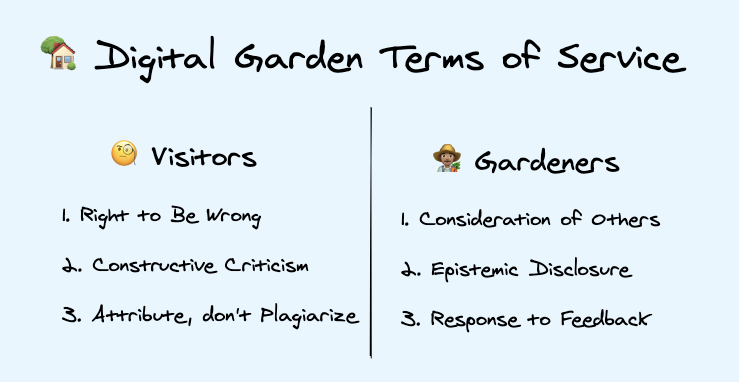A garden is a collection of evolving ideas that aren't strictly organised by their publication date. They're inherently exploratory – notes are linked through contextual associations. They aren't refined or complete - notes are published as half-finished thoughts that will grow and evolve over time. They're less rigid, less performative, and less perfect than the personal websites we're used to seeing.
Why do they exist?
-
Social media fatigue and their immediate flows.
-
New tools for thought (Roam, Obsidian, Notion).
-
More accessible web development (Netlify, Vercel, Jekyll, Gatsby, Next).
-
Need for own spaces versus closed platforms (Twitter, Medium, etc.).
What makes me want to build one?
-
Recover the creative spirit of the internet: more chaotic, personal, exploratory.
-
Response to the excess performativity and personal branding of blogs/LinkedIn.
-
It favors curiosity, idea connection, and shared learning.
What does a Digital Garden look like?
There are contested ideas about what qualifies as a garden, what the core ethos should focus on, and whether it's worthy of a new label at all. What exactly makes a website a digital garden as opposed to just another blog?
➡️ Organize by topics, not by dates.
-
Instead of having a chronological blog ("August 20th entry"), organize content in topic maps or "clusters" (e.g. Productivity, HR Tech, Internet Philosophy).
-
Use tags, categories, or index pages that serve as navigation maps.
-
Example: instead of a blog-style feed, have a section like "Garden Map" with related entries.
Gardens are organised around contextual relationships and associative links; the concepts and themes within each note determine how it's connected to others.
One of the best ways to do this is through Bi-Directional Links – links that make both the destination page and the source page visible to the reader. This makes it easy to move between related content.
➡️ Your notes aren't "finished", but alive.
Gardens are never finished, they're constantly growing, evolving, and changing. Just like a real soil, carrot, and cabbage garden.
-
Publish ideas even if they're a draft, and revisit them over time.
-
Mark versions with symbols or states:
-
🌱 Seedling: initial idea.
-
🌿 Budding: developed, but still open to improvements.
-
🌳 Evergreen: mature, stable.
-
Gardens are designed to evolve alongside your thoughts. When you first have an idea, it's fuzzy and unrefined. You might notice a pattern in your corner of the world, but need to collect evidence, consider counter-arguments, spot similar trends, and research who else has thunk such thoughts before you. In short, you need to do your homework and critically think about it over time.
➡️ Make your space have your style.
Each garden is different: You can get inspired, learn from others or grow but it has to have your style.
-
Avoid generic blog templates. Change fonts, colors, add your own visualizations.
-
Play with interactivity: sliders, collapsible notes, dynamic graphics.
-
Example: an essay with margin notes Tufte CSS style, or a navigable map with D3.js.
➡️ Make your garden yours.
Following the philosophy that Obsidian marks of File over app
- Think of your garden as a public personal library: open, exportable, durable.
- Gardens are imperfect by design. They don't hide their rough edges or claim to be a permanent source of truth.

➡️ Make your garden public
The practice of sharing what you learn as you're learning it, not a decade later once you're an "expert."
- Set norms and terms of conditions

And this, friends, is exactly what I'm building :)